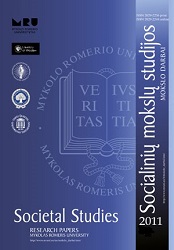Tarptautinių sutarčių bei es teisės kolizijų sprendimas europos teisingumo teismo praktikoje: tarptautiniai teisiniai aspektai
Resolving Conflicts Between Treaties and EU Law in the Case-Law of the European Court of Justice: International Legal Aspects
Author(s): Andrius MamontovasSubject(s): International Law, Public Law, EU-Legislation
Published by: Mykolas Romeris University
Keywords: conflict of treaties; conflict clause; treaties concluded by the Member States prior to the accession to the EU; treaties concluded by the Member States after the accession to the EU;
Summary/Abstract: The present article is focused on the analysis of the application of Article 351 of the Treaty on the Functioning of the European Union (ex Article 307) in the caselaw of the European Court of Justice (ECJ). The purpose of the article is twofold: firstly, it attempts to determine if ECJ infringes the rules of general international law when resolving conflicts between EU law and treaties concluded between the Member States and third countries; secondly, it aims at disclosing the content of EU law applicable in the cases of the resolution of the conflicts of treaties. The article starts with an introduction of rules governing the application of the principles of public international law in the EU. The author states that the principles or general international law are only residually applied by the ECJ, namely, in cases when EU law does not govern a specific legal relationship and the ECJ decides to apply general international law. Some scholars regard such a manner of the application of general international law by the ECJ as inconsistent with the rules of general international law. To assess this, the author applies the test of the breach of the rules of general international law to the case-law of the ECJ on the resolution of the conflicts of treaties throughout the article. The analysis of the case-law is commenced by carrying out an in depth study of the cases of conflicts between EU law and the treaties concluded between the Member States and third countries prior to the accession of the Member States to the EU. When analyzing this case-law, the author goes to the roots of such concepts as the scope of application of conflict clause imbedded in Article 351 of the Treaty on the Functioning of the European Union, the meaning of the terms ‘parties to anterior treaty’ and ‘the conclusion of anterior treaty’, the distinction between rights and obligations stemming from anterior treaties in cases of conflicts. Having shelled-out the meaning of these legal terms in the case-law of the ECJ, the author concludes that the approach of the ECJ when interpreting the provisions of EU law is ‘eurocentristic’; however, such an approach does not violate general international law. The analysis of the ECJ’s case-law is continued addressing the case-law concerning the resolution of conflicts between EU law and the treaties concluded between the Member States and third countries after the accession of the Member States to the EU. In this part, the author concludes that the ECJ follows the principle of general international law giving the priority of application to anterior treaties in cases of conflicts with the posterior ones. To sum up, the author appreciates the eurocentristic application of EU law that is consistent with the rules of general international law and contributes to its development.
Journal: Socialinių mokslų studijos
- Issue Year: 3/2011
- Issue No: 1
- Page Range: 347-364
- Page Count: 18
- Language: Lithuanian

